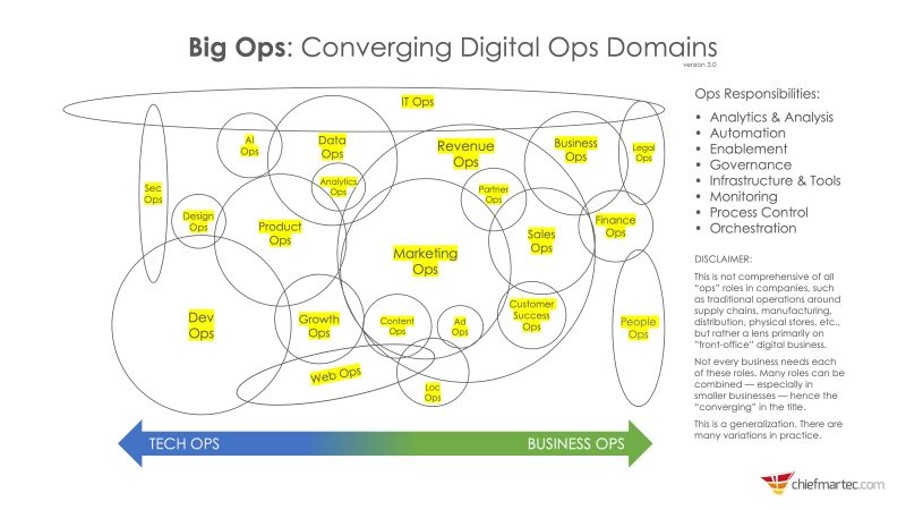Just as Big Data became the way to refer to huge benefits possible by previously unimagined access to information, Digital Ops is the term to describe what’s next. Digital Ops introduces the next step forward, and its mastery is what it takes for organizations to align people with process and technology in ways not achievable till now.
Understanding Digital Ops—a converging ecosystem of Marketing Ops, Sales Ops, IT Ops and PMO Ops—is key to persevering in an environment that has gotten cumbersome enough that it can no longer be managed by traditional mindsets, thought process or tools.
MarTech’s Scott Brinker refers to Big Ops when he talks about the proliferation of operations-oriented apps. We use the term Digital Ops because it includes the customer in the equation—not just those doing the work, but those benefiting from it. Here’s context on the concepts from Scott’s point-of-view:
The Four Vs is a commonly accepted framework used to describe the dimensions of Big Data. At Zee Jay Digital, we use it to benchmark the current, complex state of marketing, and its adjacent areas, to attain an improved state. The challenges of managing in an environment with more globalization, competition and management scrutiny than ever, coupled with an expanding number of data inputs and systemic silos, are real—but not impossible to overcome.
Digital Ops’ Four Vs—volume, velocity, variety and value—lay down the basic tenets of this most recent—and unparalleled—way to overhaul operations:
- Volume: A Lot Needs to be Done
The breadth of activity expected to be generated by marketing keeps growing. Quarterly and yearly plans are more ambitious. Getting more campaigns, programs and tactics done across a greater number of media and channel types—all within projected, invariable budgetary and fiscal restraints—is getting harder. The work tends to pile up … and the ability to manage isn’t keeping pace. Figuring out ways to get a greater volume of work done is key.
Marketing message volume (more emails, texts and push notifications to consumers) will increase 40% in 2021, according to Forrester.
- Velocity: No Stopping the Need for Speed
How fast marketing brings offerings, ideas and innovations to market matters. Developments in media channels and consumer-driven markets (and among competitors who’ve cracked the code) require marketers to respond in real-time. It takes thoughtful organization design, nimble processes and AI investment to achieve business objectives.
U.S. labor productivity will increase 35% by 2035 due to the influence of AI, according to Accenture/Frontier Economics.
- Variety: A Deluge of Options
Effective campaigns across a wide spectrum of media types—both mass and more personalized interactions—use eight, 10 or more access points. While traditional media is still relevant, social channels allow (and require) marketers to personalize efforts based on behavior and psychographic data available on buyers. This level of engagement necessitates organizational planning, training and continuous process improvement.
A one-voice-of-the-customer strategy in 2021—with a holistic approach to personalized communications across all platforms—will cut technology spend, and improve the customer experience, according to Forrester.
- Value*: How Much Is It Worth?
With the growth of capabilities that businesses now have through technology and big data, marketing organizations are increasingly required to prove their value to the business. The maturation process has taken marketers past measuring performance through campaign metrics. They now must assess total cost of marketing infrastructure, operations, and impact on the organization as a whole.
75% of enterprises will use new, external data sources in 2021 to enhance cross-functional decision-making capabilities in ways that increase value, according to IDC.
*Unlike in Big Data where veracity of data i key (and the fourth V), in Digital Ops it’s the resulting value of marketing content that it most critical … which is why the four V framework’s been altered in this context.
The 4 Vs of Digital Ops give us the means to evaluate the shift in today’s marketing, to start talking about it, to understand what it means and to take action: Improving and expanding marketing capabilities; making processes more efficient; using technology to increase effectiveness; and putting customers first. Marketers stand to gain by engaging in this important conversation.
Looking for more insight on Digital Ops? Sign up for Zee Jay Digital’s session: Workfront: Enter the Age of Digital Operations with Eric Rotkow and Veronica Bright. Wed., Apr. 28 from 3 pm to 3:30 pm.
Join the Digital Ops conversation with Zee Jay Digital: What V presents the biggest challenge at your organization?

